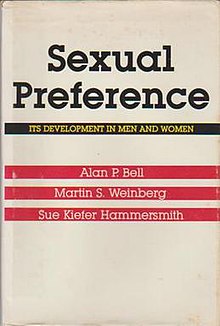 Cover | |
| Authors | Alan P. Bell, Martin S. Weinberg, Sue Kiefer Hammersmith |
|---|---|
| Language | English |
| Subject | Sexual orientation |
| Publisher | Indiana University Press |
Publication date | 1981 |
| Publication place | United States |
| Media type | Print (Hardcover) |
| Pages | 242 |
| ISBN | 978-0253166739 |
| Authors | Alan P. Bell, Martin S. Weinberg, Sue Kiefer Hammersmith |
|---|---|
| Language | English |
| Subject | Sexual orientation |
| Publisher | Mitchell Beazley International Limited |
Publication date | 1981 |
| Publication place | United States |
| Media type | Print (Hardcover) |
| Pages | 321 |
| ISBN | 0-253-16674-8 |
Sexual Preference: Its Development in Men and Women (1981) is a book about the development of sexual orientation by the psychologist Alan P. Bell and the sociologists Martin S. Weinberg and Sue Kiefer Hammersmith, in which the authors reevaluate what were at the time of its publication widely held ideas about the origins of heterosexuality and homosexuality, sometimes rejecting entirely the factors proposed as causes, and in other cases concluding that their importance had been exaggerated. Produced with the help of the American National Institute of Mental Health, the study was a publication of the Institute for Sex Research. Together with its Statistical Appendix, Sexual Preference was the conclusion of a series of books including Homosexuality: An Annotated Bibliography (1972) and Homosexualities: A Study of Diversity Among Men and Women (1978), both co-authored by Bell and Weinberg.
Using data derived from interviews conducted in 1969 and 1970 with subjects in the San Francisco Bay Area, Bell et al. attempted to test explanations of sexual orientation put forward by psychoanalysts and social scientists. They found that while homosexual men were more likely than heterosexual men to have felt especially close to their mothers, this had almost no effect on the development of male homosexuality. Poor father-son relationships appeared to be weakly connected to male homosexuality. Homosexual women were more likely than heterosexual women to describe their relationships with their mothers as negative, and to have detached or hostile fathers, but only the latter factor seemed significant. In both sexes, but especially in men, homosexuality was connected to "Childhood Gender Nonconformity", which was a measure partly of behavior more typical of the opposite sex and partly of subjective feelings of masculinity and femininity. Sexual abuse and labeling by others played no significant role. Bell et al. concluded that psychoanalytic explanations of sexual orientation are inadequate. They suggested that while bisexuality may be subject to influence by social and sexual learning, the development of heterosexuality and homosexuality may have a biological basis, possibly influenced by hormonal factors. They hoped that demonstrating a biological basis to homosexuality would have beneficial effects such as increasing tolerance of gay people.
Seen as likely to provoke controversy even before its publication, Sexual Preference received considerable media attention, and mixed reviews. Critics questioned Bell et al.′s reliance upon a statistical technique, originally developed for use in the biological sciences, called path analysis, disputed the representativeness of their sample of homosexuals, pointed out the difficulty and potential unreliability of adult recall of childhood feeling and the vague and general nature of the questions respondents were asked, and disagreed with Bell et al.′s suggestion that sexual orientation is innate. Nevertheless, some reviewers complimented Sexual Preference for its authors' challenge to established views about the causes of homosexuality, and it eventually came to be considered a classic work. It is one of the most frequently cited retrospective studies relating to sexual orientation, credited by psychologists with disproving psychoanalytic theories about the development of homosexuality. It was the last study on homosexuality released by the Institute for Sex Research.
